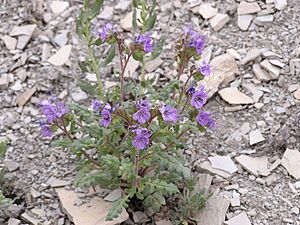Clay phacelia facts for kids
Quick facts for kids Clay phacelia |
|
|---|---|
 |
|
| Conservation status | |
| Scientific classification | |
| Genus: |
Phacelia
|
| Species: |
argillacea
|
Phacelia argillacea, also called clay phacelia or Atwood's phacelia, is a very rare flowering plant. It belongs to the borage family. This special plant only grows in one canyon in Utah County, Utah, in the United States. It's considered one of the rarest and most endangered plants in the entire country. The U.S. government lists it as an endangered species, meaning it's at high risk of disappearing forever.
Contents
What Does Clay Phacelia Look Like?
This plant is an annual herb, which means it lives for only one growing season. It can grow up to about 36 to 40 centimeters (about 14 to 16 inches) tall.
Leaves and Flowers
At the bottom of its stem, the plant has a group of leaves that form a circle, like a rosette. These leaves are long and narrow, up to 5 centimeters (2 inches) long. They have deep cuts or lobes along their edges.
The flowers grow in a special cluster called a cyme. This cluster has several branches that curl like a scorpion's tail. The whole flower cluster is covered in tiny hairs and sticky glands.
Each flower is bell-shaped and has a beautiful purple-blue color. It's about 0.5 centimeters (0.2 inches) wide and long. Long stamens (the parts that make pollen) and a style (part of the female reproductive organ) stick out from the flower's opening.
Life Cycle of the Plant
After the flowers, the plant produces a small fruit called a capsule. This capsule is about a quarter of a centimeter long.
Clay phacelia is usually a winter annual. This means its seeds sprout in the fall. A small rosette of leaves forms, and the plant grows slowly through the winter, often under the snow. By May, its main stem starts to grow upright.
The plant usually blooms in July, but sometimes flowers can appear as early as May or June. Some flowers might even last until October. A single plant can produce a lot of seeds, sometimes up to 8,000! This plant is very similar to another species called Phacelia glandulosa.
Where Does Clay Phacelia Live?
This unique plant is only found in Spanish Fork Canyon in central Utah. It has been on the U.S. Endangered Species List since 1978. Back then, only nine individual plants were known to exist. Within two years, this tiny group had shrunk to just four plants. In 1980, a second group was discovered, bringing the total number of plants in the world to about 200.
Its Special Home
The clay phacelia grows on steep hillsides. These slopes are made of clay and broken pieces of shale rock. These rocks come from a geological formation called the Green River Formation.
The area where it lives is a pinyon-juniper woodland. This means it's a forest mainly made up of Pinus edulis (Colorado pinyon pine) and Juniperus osteosperma (Utah juniper) trees. Other plants growing nearby include:
- Mentzelia laevicaulis (giant blazingstar)
- Mahonia repens (creeping barberry)
- Oenothera caespitosa (evening primrose)
- Marrubium vulgare (horehound)
- Cynoglossum officinale (houndstongue)
- Amelanchier alnifolia (serviceberry)
- Rhus trilobata (skunkbush)
- Atriplex canescens (fourwing saltbush)
- Artemisia tridentata (sagebrush)
- Chrysothamnus nauseosus (rabbitbrush)
- Cercocarpus montanus (mountain mahogany)
- Rosa woodsii (Woods' rose)
Why Is Clay Phacelia Endangered?
The clay phacelia faces several challenges that put it at risk of extinction. Because there are so few plants, any problem can have a big impact.
Threats to the Plant
- Grazing Animals: Sheep graze very close to where the plants grow. Native animals like mule deer and rock squirrels might also eat the plants.
- Human Activity: One group of plants grows right next to railroad tracks. Building and maintaining the tracks can disturb the plant's home. Also, Highway 6 goes through another area where the plants live. Road work can harm the plants and the habitat for their pollinators (insects that help plants reproduce).
- Competition from Other Plants: Some plants that are not native to the area, like horehound and houndstongue, can grow quickly. These introduced species might compete with the clay phacelia for space, water, and sunlight.
How Are We Protecting Clay Phacelia?
People are working hard to protect this rare plant. Conservation efforts include growing new plants and collecting seeds.
Protecting Its Home
Both natural groups of clay phacelia plants are on private land. This makes them harder to protect directly. However, seeds grown in special plant nurseries will be used to start new groups of plants. These new groups will be planted in thirteen different spots on federal land in Uinta National Forest. This way, they can be better protected and watched over.


